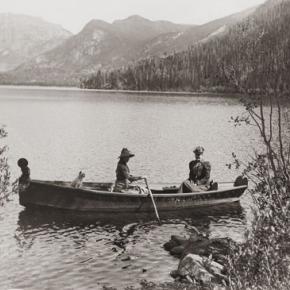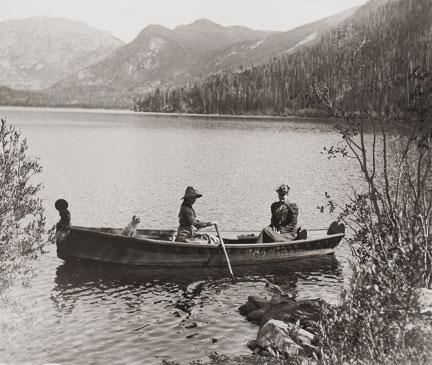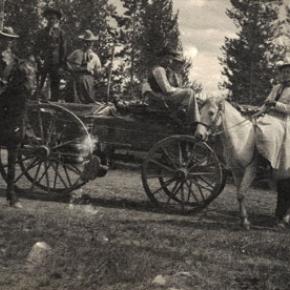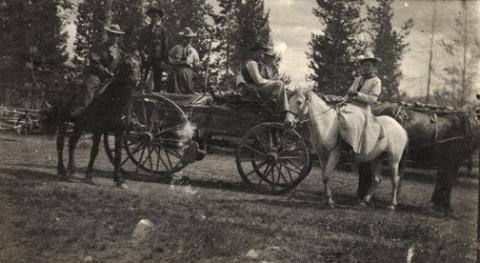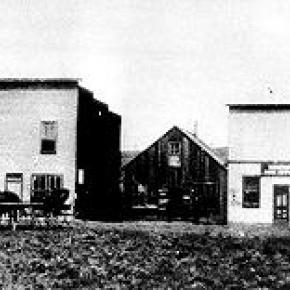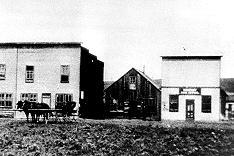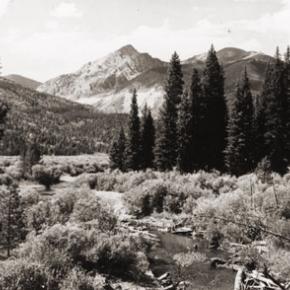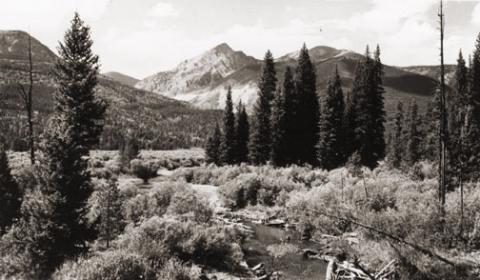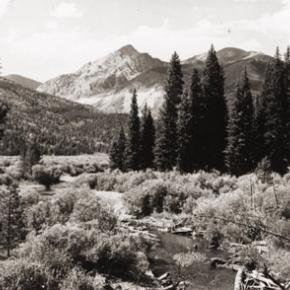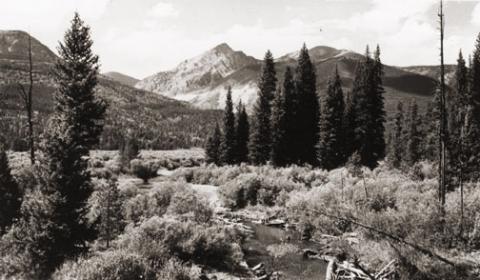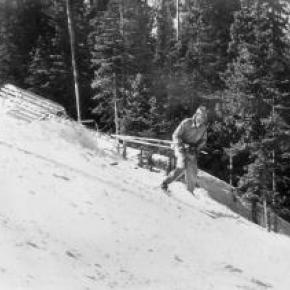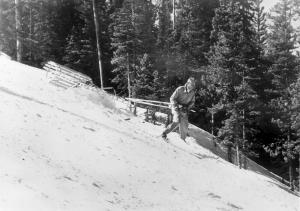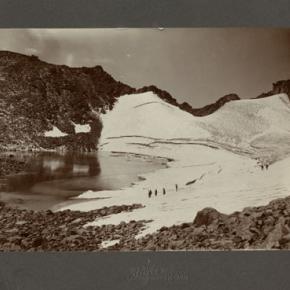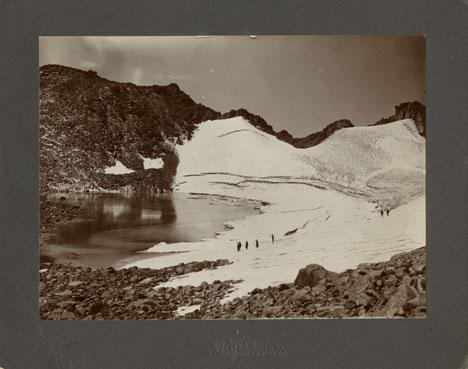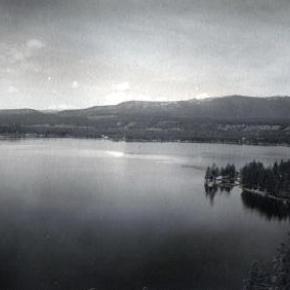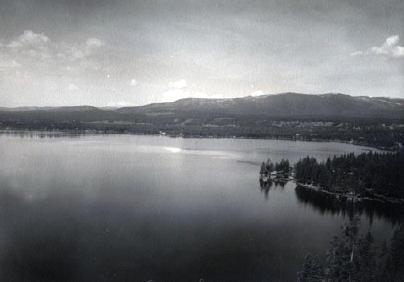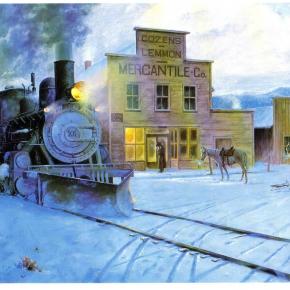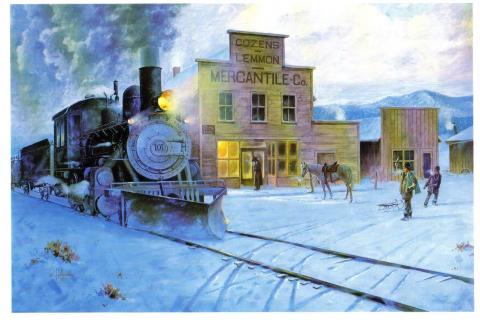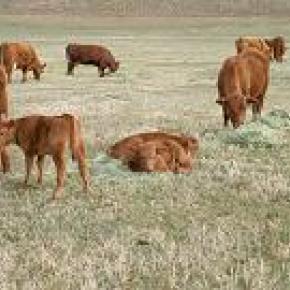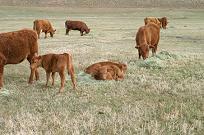Business/Industry
How did people make a living? What were some of the businesses and industries that brought people to Grand County?
Business/Industry Articles
| Agriculture of Grand County |
Agriculture of Grand County
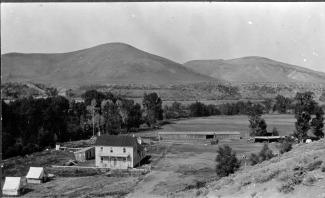
The first settlers in Granby realized the sunny days and cool nights were perfect for growing one crop in particular, lettuce. Lettuce farming boomed in the 1920's and a new industry was born. Granby had become an important railway center as tracks were laid over the Divide at Rollins Pass,giving the Moffat Railroad access to Salt Lake City. |
| Devil's Thumb Ranch |
Devil's Thumb Ranch
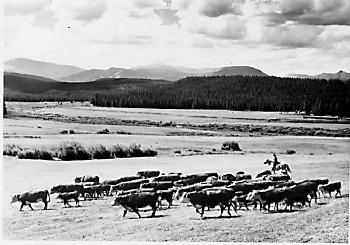
According to local lore, Native Americans named Devil's Thumb, a rocky outcropping that towers high above the Ranch. As legend goes, after the warring Ute and Arapahoe tribes settled their differences in the |
| Dude Ranches |
Dude Ranches
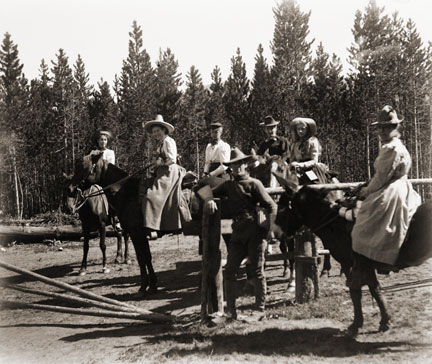
Starting in the late 1870s, ranchers took in guests to supplement their income during hard times. Early adventure-seekers from the East made the long rail journey to the wilds of Middle Park in search of big game and unspoiled mountain scenery. With few accommodations available, travelers looked to frontier families for room and board. Ranchers soon discovered guests, or “dudes” as they came to be known, would pay to fix fences, ride horses, work cattle and sleep in tents....sometimes for an entire summer! Entertainment was eventually incorporated into the guest experience. |
| Dutch Town |
Dutch Town
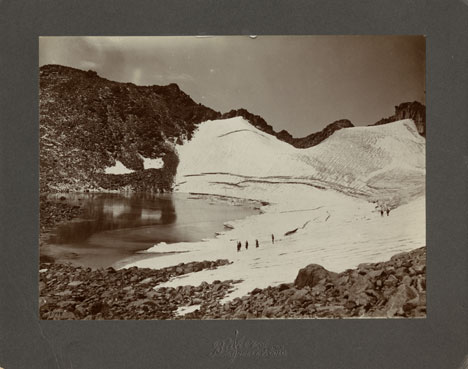
When two Germans, having imbibed too liberally shot up the mining town of Lulu City, they were run out of town. They went higher and established camp, on the side of Red Mountain near timberline. There they found a lode of low grade gold, silver and lead. While it lasted only two years, this encampment came to be called "Dutch Town". Gradually the fierce winters and lower quality of ore drove the settlers out, leaving only a few empty cabins about a mile west of Lulu City.
|
| Dwight D. Eisenhower and the Western White House |
Dwight D. Eisenhower and the Western White House

Dwight D. Eisenhower met and married Mamie Geneva Doud of Denver on July 1, 1916. Carl Norgren, a Doud family friend, had started spending time in the Fraser area and was enchanted by the beauty of the area and especially the Byers Peak Ranch for Boys. Eisenhower used his time at the Byers Peak Ranch to rest and recompose himself in the face of difficult political times. As President, Eisenhower dealt with the threats of the Cold War, a truce in Korea, the desegregation of public schools (Little Rock, Arkansas), and the development of the "Eisenhower Doctrine" to bolster the Middle East against the threat of communism. On the domestic front, he was faced with the difficulties of dealing with the Republican Old Guard, including Senator Joseph McCarthy, who headed a subcommittee charged with the finding of communists within the government. Eisenhower enjoyed cooking for guests at the Ranch, fishing St. Louis Creek and having "brookies" (brook trout) for breakfast, painting, and playing golf. On September 24, 1955 while at the Ranch, Eisenhower suffered a coronary thrombosis (heart attack) and was hospitalized at Fitzsimmons Army Hospital in Denver until November 11, 1955. His hospital suite has now been restored and is open for limited tours. |
| Gaskill and the Wolverine and Ruby Mines |
Gaskill and the Wolverine and Ruby Mines
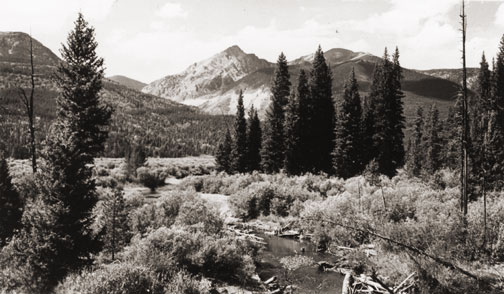
The Wolverine Mine was discovered in 1875 by James Bourn and Alexander Campbell. Bourn was the brother-in-law of James Crawford, the founder of Steamboat Springs. James Bourn was the twin brother of Crawford's wife, Maggie. A Grand County recording error forever changed the name of Bourn in the area to "Bowen". The mine was located in the Rabbit Ears Range on Bowen Mountain, up Bowen Gulch, approximately 10 miles northwest of Grand Lake. This discovery sparked additional exploration in the area that lead to a number of new mines. Within a week of the original discovery, interested parties formed the Campbell Mining District which included Bowen Mountain, Bowen and Baker gulches. Some of the Middle Park residents who participated in the mining exploration were John Baker, Charles Royer, Charles Hook, John Stokes and the Redman brothers, William and Mann. The Redman's eventually discovered the Sedalia mine. Bourn and Campbell in less than a year lost the Wolverine mine by not fulfilling a grubstake agreement with the Georgetown grocers, Spruance and Hutchinson. John Stokes leased the Wolverine Mine from the grocers until Edward Phillip Weber, an agent representing a group of Illinois investors, purchased the Wolverine Mine in the Summer of 1879. Weber continued purchasing other Campbell Mining District claims which created a great deal of local excitement. Weber hired Stokes to assist him and also hired Lewis Dewitt Clinton Gaskill to act as the first foreman for the Wolverine mine. Gaskill had mine operation experience, having successfully operated the Saco Mine, on Leavenworth Mountain, above Georgetown for several years. A mining camp was built below the Wolverine Mine that contained a large bunk house building and a more substantial mine office building. Gaskill, a Civil War veteran of the 28th Regiment of the New York Volunteer Infantry, had come to Colorado in 1868 as a representative of a group of Auburn, New York bankers to invest in mining properties. He eventually successfully operated the Saco mine in 1873 and 1874. He invested in the Georgetown, Empire and Middle Park Wagon Road in 1874, which was a toll road that finally made the Berthoud Pass road passable for wagon traffic. Gaskill also acted as the foreman during the construction of the road. The principal investor in the road was William Cushman of the First National Bank of Georgetown. The bank had a financial collapse in 1877. At that time, Gaskill was the secretary of the road company and lived with his family in the company house just below the summit of Berthoud Pass on the west side. William Hamill, a wealthy Georgetown businessman, bought the wagon road in a foreclosure auction in 1881 for $7,000. Gaskill continued to live with his family in the Berthoud Pass summit house until 1885, when he moved his family into the Fraser Valley and homesteaded 160 acres along Elk Creek. The settlement of Gaskill began when in August of 1880, Al J. Warner built a log cabin store in a meadow below Bowen Gulch on the trail/road that lead to both Bowen Gulch and Baker Gulch. The settlement was also strategically well placed midway on the trail/road between Grand Lake and Lulu City and the Lead Mountain Mining District. Another store was built in September by John K. Mowery. By that October, Mowery was appointed as the first postmaster of Gaskill. The following spring E. Snell, opened a large general merchandise store that prompted the original store keeper, Al Warner, to relocate to Grand Lake as Al's Place. The town was named to honor L.D.C. Gaskill, the greatly respected foreman of the Wolverine Mine, the road builder/operator and the Civil War veteran. By 1882, the town covered 60 acres. E.P. Weber of the Grand Lake Mining and Smelting Company got involved in the town real estate development by laying out a city grid and offering lots for sale. Weber's plat renamed the town Auburn after L. D. C. Gaskill's home town of Auburn, New York, but the Gaskill name stuck. By the close of 1882, there were over 100 residents living in Gaskill. The most substantial building was the Rogerson House, a well appointed two story, squared log hostelry, Horatio Bailey Rogerson, proprietor. Rogerson, would be elected County Commissioner in November of 1882, but would not serve because of a sudden discovery of ineligibility. Instead, lame duck Colorado Governor Pitkin, appointed E. P. Weber to the post. Weber was killed in the infamous July 4, 1883 shoot-out at Grand Lake. The Bowen Gulch trail lead to many of the most productive and worked mines in the Campbell Mining District which included the Wolverine, now owned by the Grand Lake Mining and Smelting Company, E. P. Weber superintendent and the Ruby and Cross mines owned by Kentucky and Colorado Mining and Smelting Company, John Barbee superintendent. Barbee, who lived in Grand Lake, would go on to serve as superintendent of schools, Justice of the Peace and briefly the editor of the Grand Lake Prospector. Barbee's partner in many endeavors was Antelope Jack Warren. Warren was as rough as Barbee was refined. He acted as a foreman and, by one account, a bodyguard for Barbee. The Bowen Gulch trail continued up the mountain to Bowen Pass and then descended into North Park and the Jack and Park mining districts which were organized by the end of 1880, to the settlement of Teller City. Passable roads that could handle wagon traffic were needed and often planned but rarely built. The high cost of building and maintaining wagon capable roads in Middle Park was a difficult proposition for local governments and private entrepreneurs. The Grand County Commissioners in July of 1877 had declared the trail from Grand Lake to the mining gulches of the Rabbit Ears Range to be a county road. However there was little county money to pay for improvements to make the trail a road. Private investors were reluctant to invest in wagon roads when there was the persistent rumor that railroads were coming spawned by the numerous railroad surveys that were performed in the area. Albert Selak, a Georgetown brewer, in August of 1878, organized a toll road that would branch off of the Georgetown, Empire, and Middle Park Wagon Road at the Ostrander Ranch on Red Dirt Hill, and proceed to Grand Lake and continue on to the Rabbit Ears Range mines and continue on into North Park and on to the Wyoming territory line. John Barbee invested in the Middle Park Toll Bridge Company, a toll bridge company that intended to build a bridge across the Grand River above the confluence of Willow Creek and the Grand River. However, this project languished, and was taken over by the county with an expenditure of $150. If ore wagons would need to haul ore to the nearest reduction mill which was over 60 miles in Georgetown, the toll road might have been a financial success. However, the lower grade ore from these Rabbit Ears Range mines would not yield a sufficient profit to cover the transportation and processing costs in a market where the market value of silver annually declined. So the ore piles grew. What was needed was a nearby reduction mill or cheaper transportation, like a railroad or a higher price for silver. Weber had repeatedly promised that a reduction mill was coming, but nothing was ever built. By April of 1883 with tons of ore piled up and waiting for transport to be processed, Weber temporarily closed the Wolverine Mine and laid off his miners. He admitted in June of 1883 that the ore from the Wolverine was “rather refractory” and that it would not justify shipment without local reduction. Some hoped the closing was a strategic move by Weber to trigger a sell off of area mining properties so that he could acquire additional mines before he built the reduction mill, but it was not to be. Weber would soon be shot dead by his political rival, John Gillis Mills. The favorable newspaper stories of Rabbit Ears Range mining would continue, but for the informed, it had become clear that without a major investment in improved transportation including a railroad or a major investment in a reduction mill in the area, the mining concerns were doomed to fail. Mining claims had to be worked in order to be kept. A minimum of $100 of labor or $500 in improvements had to be expended each year to maintain the claim or else the claim would be deemed abandoned. Many claim holders leased their claims to miners to work for a percentage of the return. Without the ability to sell and process the ore for a profit, there was no return. The speculative mining investment money began to dry up and the miners and their supporting merchants began to leave. By the end of 1886, the Middle Park mining boom had ended. To further add to the decline, a border dispute that arose between Larimer County and Grand County over the taxation and mineral wealth of North Park was finally decided in 1886 by the Colorado Supreme Court in favor of Larimer County. North Park was part of Larimer County, not part of Grand County. A lawsuit would follow so that Larimer County could recover the wrongly collected taxes of $20,000 from Grand County. Grand County's total tax income at the time was less than $3,500 a year. |
| Logging |
Logging

In the early decades of Grand County, lumbering was a key contributor to the local economy. Logging was necessary as the principal source of building construction and also as the only available fuel. When the railroad first made its way over Rollins Pass, the production of railroad ties became an important industry. In the Grand Lake area, the brief mining boom of the 1880s created a steady demand for timber. Some remains of log structures from abandoned logging camps were still evident late in to the 20th century. These include the Middle Park Lumber Company on St. Louis Creek (southwest of Fraser), an operation that had it's own railroad line into town. In the same area, the independent logging settlements of Lapland and Stockholm date back to 1915. Above Tabernash was located the Deiler Mill, ten miles up Hurd Creek. In 1910, the Western Box Company bought the mill and moved it to the head of Meadow Creek. A box factory was located in Tabernash and the logs were floated down in a flume, thirteen miles long. Mrs. Braddock was the "flume lady" at one time and would balance on a log while breaking up log jams on the trip downstream.....a task that required "great skill and derring-do". Other operations included Koppers Camp up Pole Creek (above Tabernash), Mr. Daves Mill at Hideaway Park and Bob Morrow's camp on Byers Peak. Broderick Wood Products Company of Denver was a major purchaser of Grand County timber starting in 1930. In 1939, Smokey Harrison founded the Timberline Sawmill at Kremmling. A huge box making plant was built on a site now covered by Granby reservoir. Its main supply point was a logging camp at southwest corner of Monarch Lake. You can still see remnants of the logging machinery along the shore of the lake. For a short time there was a branch railroad from Granby to the box factory, which later burned to the ground, In 1949, American Timber built a sawmill and log pond at Granby, west of the Highway 40 overpass. The west end of the county was logged by the Kremmling Division of the Edward Hines Lumber Company. Later, Louisiana Pacific built a wafer board plant in Kremmling but it closed in the 1980's. The short growing and harvesting season created many challenges for the loggers. According to Ed. "Jr." O'Neil, it takes over 100 years in Grand County to grow a tree big enough got a 35 foot telephone pole. In contrast, it would only take 30 years to grow a similar tree in warmer climes. There is still private logging activity in Grand County, most of it for the construction of luxury log homes. |
| Lulu City |
Lulu City
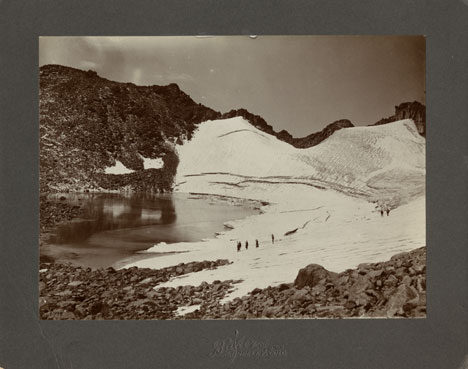
A popular hiking trail in Rocky Mountain National Park leads to the site of the historic mining town of Lulu City. When precious metals were discovered there in 1879, as many as 500 prospectors showed up. When the mines played out four years later, they departed in haste for other promising boom towns. Lulu City was named for the daughter of Benjamin Franklin Burnett, one of the town founders. At its height, the town had a hotel, post office, and a justice of the peace. It was served three times a week by a state coach from Fort Collins, on the other side of the Continental Divide. There were probably ten saloons which drew customers from various mines in the area, such as the Rustic, Friday Nite, Tiger, Carbonate and Southern Cross. These yielded low grade gold, silver and lead but the remote location of the Lulu made the cost to process the metals so high that efforts were soon abandoned. The closest smelters were probably well over 100 wagon miles away. One of the more remarkable characters of Lulu was "Squeaky Bob" Wheeler. His high pitched voice was unique. He was subject to drinking bouts, but was usually a likeable, well-behaved citizen. After working in the mines, Squeaky Bob saved enough money to purchase a ranch south of Lulu. There he established a guest house and became famous for his cooking skills and colorful hospitality. The current Lulu City trail runs through the site of his property, which was named the Phantom Valley Ranch. He sold the ranch in 1926, but it continued to be a popular tourist stop until it was included in the National Park boundaries. |
| Mining |
Mining
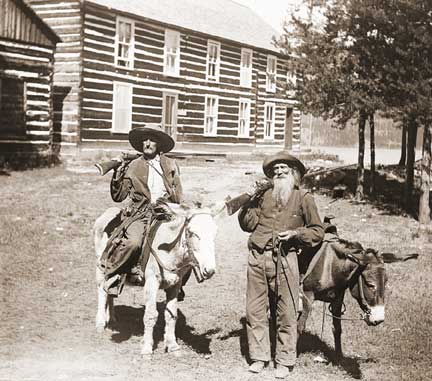
Ghost towns and broken dreams are legacies left by the early miners and prospectors of Grand County. Ever since 1879 when the first mines were staked out and claimed on Bowen Mountain near Grand Lake, “gold and silver fever” grew like an epidemic. Men blinded by greed and prospects of a better tomorrow scrambled to the Kawuneeche Valley with picks and shovels to unearth their fortunes. Women worked just as feverishly along side their men and encampments gave way to mining towns almost overnight. Land offices, eateries, and boarding houses sprouted like wild flowers. |
| Mining in Grand County |
Mining in Grand County
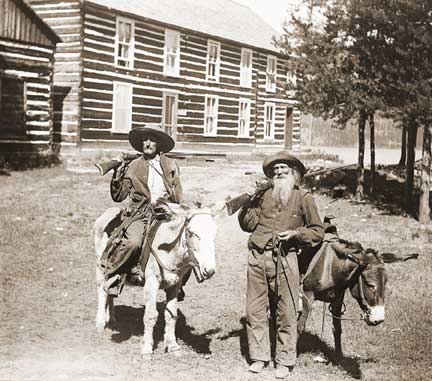
Ghost towns and broken dreams are legacies left by the early miners and prospectors of Grand County. Ever since 1879 when the first mines were staked out and claimed on Bowen Mountain near Grand Lake, “gold and silver fever” grew like an epidemic. Men blinded by greed and prospects of a better tomorrow scrambled to the Kawuneeche Valley with picks and shovels to unearth their fortunes. Women worked just as feverishly along side their men and encampments gave way to mining towns almost overnight. Land offices, eateries, and boarding houses sprouted like wild flowers. Claim jumping became a common practice, resulting in fights and even murders. Most of these injustices would go unpunished, for no one wanted to risk losing their chance of riches. In Grand County the mother load was a false prophecy, as only small quantities of low grade gold, silver, and lead ore were found. In a few short years, Gaskill, Teller City, and Lulu City, three of the more noted settlements, suffered the same fate as the other boom towns. By 1885 the mining boom had ended in Grand County and ranching had taken it’s place as a sustaining industry. |
- 1 of 2
- next ›









